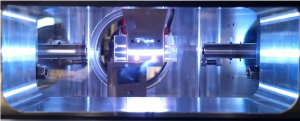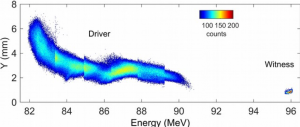
Using an innovative technique, researchers from the SPARC_LAB group have recently demonstrated the acceleration of a high-quality electron beam in a plasma accelerator. The experiment highlighted, for the first time, the possibility to reduce the energy spread during acceleration.
This important result, recently published by the group on Nature Physics [1], was obtained by imprinting a positive energy-chirp on the beam (particles in the head with larger energies than those on the tail) before it enters into the plasma. By doing so it is possible to pre-compensate the energy spread induced by the plasma itself thus giving the possibility to minimize it at the exit.
The experiment was carried out with the SPARC_LAB photo-injector, that generated and pre-accelerated two distinct electron bunches, driver and witness. Using a 3 cm-long capillary containing hydrogen gas, ionized in plasma by a high voltage discharge (Figure 1), accelerating fields of the order of 230 MV/m were generated by the driver and used to accelerate the witness. Figure 2 shows the two bunches at the plasma exit measured through a magnetic spectrometer. Witness and driver initially had the same energy of about 89 MeV. The plasma density was set to 2×1015 cm-3 during the experiment. In such a way, by positioning the witness about 1 picosecond after the driver, it was possible to exploit the accelerating field produced in the plasma by the driver itself.

The complexity of the experiment is considerable if we consider the dimensions that are involved. The two bunches have sizes of few tens of microns and must be placed in the plasma with precision of the order of microns. This advancement in the generation of high-quality beams is of paramount importance because it makes the accelerated beam really “usable” for applications such as Free-Electron Lasers (FEL). For that reason, a pilot experiment is currently in progress at SPARC_LAB with the aim to inject the plasma accelerated witness into the undulators to obtain FEL radiation emission.
The published manuscript also describes how the same method can be scaled to larger energies and different configurations, such as the future user-facility of EuPRAXIA@SPARC_LAB. Given also the recent approval of funds for the project, these results represent an important milestone towards the use of plasma acceleration for user-oriented applications.
References
- R. Pompili et al, “Energy spread minimization in a beam-driven plasma wakefield accelerator”, Nature Physics, https://www.nature.com/articles/s41567-020-01116-9
 INFN-LNF Laboratori Nazionali di Frascati
INFN-LNF Laboratori Nazionali di Frascati